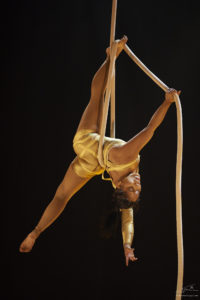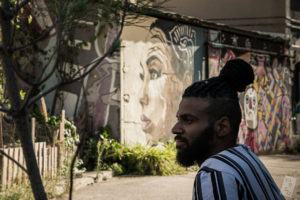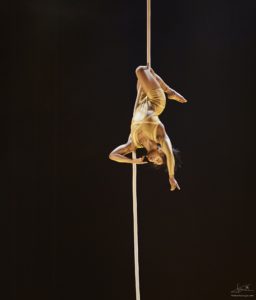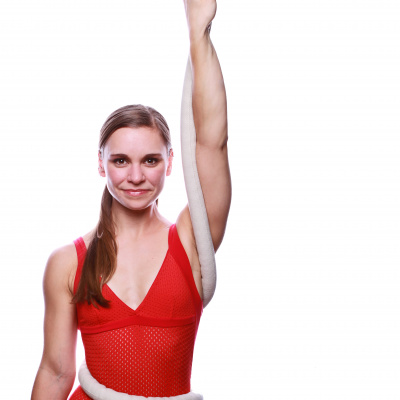Circus Bodies: BIPOC Circus Bodies
Last week was the one-year anniversary of George Floyd’s murder. Last summer, world-wide protests erupted and calls for real, sustainable change that would address the root of systematic racism and policy brutality were made. Individuals, communities, companies, and nations have had to face the facts about upholding social structures built on white supremacy–including the global circus community. Circus Talk launched the Circus and Changing Realities 2020 series, part of which were a series of events titled Wake Up Call for Inclusion. I caught up with Noeli Acoba and Marco Motta, panelists in the very first iteration, hosted by Johnathan Lee Iverson. This article is a check in to see if and how things have shifted in the past twelve months.
Motta was born in Salvador de Bahía in 1992, and trained in Brazil as a dancer and contortionist. These styles have become his true artistic expression. He chose b-boying/breakdancing as a channel toward other artistic languages and specializes in aerial straps. In 2020, he created, directed Blackbird in which he also plays the protagonist. Motta won the Special Jury Award at Mondial Du Cirque De Demain (2017), as well as Third Prize and CircusTalk’s Critic’s Choice Award at FIRCO Ibero-American Circus Festival. Motta has spent the majority of the past year in Spain.

Acoba is a Montreal-based circus artist specializing in aerial rope. She has trained with Eric Newton (Cirque du Soleil, Cirque Éloize) and Irena Purschke (École National de Cirque, Montreal) and was a company member at Kinetic Theory Circus School in Los Angeles, California. She performs internationally and has done collaborative research with Cirque du Soleil and Acrobatic Conundrum. Acoba is currently leading the American Circus Alliance’s (ACA) Diversity , Equity, and Inclusion Committee.
I asked Acoba what positive changes she had experienced or witnessed in the past year. She replied, “I’ve seen circus companies prioritize bringing in talented BIPOC circus artists into their casts in both the US and Canadian contemporary circus sectors. I’ve also seen more microgrants, such as Connecting Circus Students Around the World (CSAW), and scholarships dedicated to helping BIPOC circus artists. Most of all, I’ve experienced being in the midst of the US contemporary circus sector coming together to discuss the reality that there needs to be more BIPOC representation, and we need to collectively create inclusive spaces where this can happen. It’s amazing that these conversations are happening and that so many people are with it and for it.” [1]
In conversation with Motta, he explained that his community was comprised of like-minded people, so he had not necessarily experienced shifts within his circus community, but that the greater treatment of Black people in Spain and Brazil had not improved. He expressed that the extreme right and the presence of Nazis was growing and that physical violence had increased. He said that real time political events were topics of conversation amongst his peers, but substantial change was slow “because we don’t have the power right now.”
That’s why I do contemporary circus: my contemporary identity is happening now.
Protesting is one way to be visible, show support, and hopefully create change. For Motta’s community, current events and politics were inextricably linked to art making. Motta said, “The circus is just one of hundreds of artistic languages. For me, it is really important to express what is happening right now. That’s why I do contemporary circus: my contemporary identity is happening now.”

Motta’s most recent show, Blackbird, addresses mental health in Black communities. In it he shares personal stories of anxiety, depression, and suicidal thoughts. He hopes the show will change dangerous perspectives about Black people and explained, “People always have this kind of idea about us, like, ‘You are so strong, you have this strong mentality, you don’t have any problems because right now you have a stable life.’ I would like to say to people, ‘No, we have a lot of problems. For example, me, I have anxiety and depression. People need to be concerned about this, and try to find help–the people from my community and the people from outside of my community. The white people need to understand what they do has a direct effect on our lives. When you vote, you a have direct effect, immediately, on my community. For example, if you go to [support] Bolsonaro or Donald Trump, you need to understand this really affects us. If every single day you joke about my hair, or my skin or, or my music, these affect me. And we are not that strong, like people imagine. We are humans, we are just people who try to survive.” Motta said that as the pandemic eases, his goal is to tour Blackbird.

While I asked Acoba what she thought still needs attention, time, effort, or funding, she replied, “The most prominent problem that I see in the US contemporary circus sector is the need for more BIPOC individuals in leadership positions in contemporary circus companies and schools/studios.” When I asked Motta what he would specifically like the Circus Talk readership to know, he echoed Acoba’s sentiment of representation. “I speak directly to the directors and producers and people in power and this, it’s really important for these people to understand we need to have a good representation. We have the talent, we have everything to work, just give us the opportunity to make what we love. Now, I don’t speak about me I speak about the young people, they are the people with hunger, the new people in this world. When you put someone like us on stage, don’t try to exoticize us. Dignify our bodies. The work of the director is really important to create new social constructs about us. Art is really important to change the collective image of people.”
Both Acoba and Motta spoke about how continued change is necessary. Acoba said ACA’s Diversity, Equity, and Inclusion Committee is creating “guidelines and resources for promoting equity, diversity, and inclusion of BIPOC circus artists in circus spaces. For instance, one potential resource that was discussed is a clear explanation of what a microaggression is and the types of microagressions that BIPOC circus artists experience within circus companies and/or in training spaces. Learning and understanding what BIPOC circus artists experience can lead to more inclusive environments.”
Don’t try to be inclusive. Because being inclusive is to include us in the racist system; it’s not changing.
In the past year, the difference between diversity and inclusion has been highlighted. Diversity, while an important and necessary attribute of a community or company can tend toward labels, fuel stereotypes, or be a slippery slope toward tokenism. Inclusion insists that groups go beyond a purely visible or quantitative representation and toward active listening, respect, and equity. As Michael Garner spoke about in a previous article, it is about honoring individuals as three-dimensional. Inclusivity is a bigger step toward equity than diversity, but Motta suggested that even inclusivity does not bring us far enough. “Don’t try to be inclusive. Because being inclusive is to include us in the racist system; it’s not changing. To change [is to] have the opportunity to start again. Change the system. Change it, change your mind [and how] you think about us.” Motta spoke about how there are plenty of non-white people with the ability to perform at elite levels and worthy of being on stage. “The problem is not quality. The problem is the vision of the directors and producers, and that’s what we need to change this year.” He expanded on this and said that the opportunity to be on stage is a vital experience for performers, but if people are not given the opportunity, of course they will not develop the skill. Motta succinctly said, “Just give us the opportunity to make what we love.”

Motta closed our conversation by saying, “I would like to say to my people, to still have hope that things can change. And we need to keep fighting. Because the system would like to make us invisible. We need to be still here. We need to be still screaming. If we need to burnout, burnout. Because that’s when people hear us: [when we are] still standing, still resistant.” Repetition and visibility is powerful, and conversations, planning, and DEI trainings that empathize with the lack of representation and continual exoticization of BIPOC bodies in contemporary circus have become more prolific in the past year. But true empathy must result in action. As circus training spaces and performances reemerge in a post-pandemic world, will habits, ideals and structures in circus communities truly, significantly change in order to be more inclusive? Will all these panel discussions and articles amount to tangible change? Will directors, programmers, educators, and producers heed the call to use their privileged positions to not just be inclusive, but change the system? How circus education, research, funding, and performances are approached in the coming months will be the true evidence of what has shifted in the past year.
Below: Teaser video for Blackbird, concept, direction and performance by Marco Motta.
Footnotes [1] "With it and for it" is an expression that harkens back to traditional circus lots. "With it" means someone works with a circus or carnival. "For it" means you do not work for an operation but have some other affiliation. The phrase also means that you are suited to the unique lifestyle of circus.
Featured Image: Design by Emily Holt. Photo credits: Joel Deveraux, Marina Levitskaya,James Loudon, Gaby Merz, and Georges Ridel.
Related Content: Circus Bodies: Meaning Makers and Culture Creators, Wake Up Call for Inclusion 01 – Institutional Barriers and Individual Biases in the Performing Arts, Wake Up Call for Inclusion 03 – Institutional Barriers and Individual Biases in the Performing Arts for Women of Color
Do you have a story to share? Submit your news story, article or press release.




